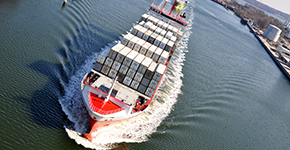Beyond its regional importance for the economy of the Federal State of Schleswig-Holstein, Kiel Canal is nationally and internationally reputed as
…ONE OF EUROPE’S MAIN TRANSPORTATION ROUTES:
With more than 35,000 ship transits per year, Kiel Canal is the world’s busiest artificial waterway, ahead of the Suez-Canal and the Panama-Canal. The amount of cargo transported through Kiel Canal increased by 150 percent between 1999 and 2008 – and it will continue to grow. The Baltic region is one of the gravity centres of economic prosperity and growth in Europe, with continuously increasing trade volumes. As a shortcut into the Baltic Sea, Kiel Canal helps to keep transport costs at bay in times of increasing fuel prices. By reducing the length of sea transport it contributes to the reduction of air emissions and thus to climate protection. And, finally, it facilitates the relocation of cargo transport from road to sea – relieving the shoreside road and rail transport grid which increasingly approaches its capacity limit.
…IS ONE OF THE KEY COMPETITIVE FACTORS OF THE GERMAN SEA PORTS:
As a fast and efficient shortcut to the Baltic Region and to Russia, Kiel Canal is one of the most important hinterland connection elements of the Ports of Hamburg and Bremen as well as the JadeWeserPort. Using German ports and Kiel Canal for onward transportation saves sailing distance, cost and time, resulting in an important competitive advantage of German ports over their main rival in the Netherlands and Belgium. A decline of this advantage would inevitably result in relocations of long-distance container services to the other ARA-Ports (Antwerp, Rotterdam and Amsterdam) with onward connections to the Baltic via the Skagerrak. Other cargo would be redirected to long-distance services directly calling Baltic ports such as Gdansk. If this should ever happen (as a result of insufficient capacity and reliability of Kiel Canal), it will most likely result in a lasting shift of cargo flows – German ports would find it extremely difficult to win their clients back. At the moment, the national ports still have a dense network of long-distance and feeder services, which fulfils an important function in the procurement of Germany’s economy with primary products and the export of German goods.
…ENSURES WORK AND VALUE CREATION:
In the Federal State of Schleswig-Holstein Kiel-Canal generates about 3,500 jobs. But these represent just a minor part of the work generated by this waterway: Kiel Canal facilitates the development of ports and maritime industry including yards, brokers and agents, ship suppliers, service companies, etc. The Canal as well as Germany’s ports are centres of industry, trade, tourism and gastronomy. These beneficial effects are still felt far away from the coast and Kiel Canal.
Some facts & figures: Germany’s sea ports – which depend on a well-functioning Kiel Canal – generate employment for about 500,000 people. They create an annual gross value of about 29 billion euros and (German) tax income of between 10.2 and 11.6 billion euros.





